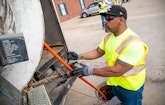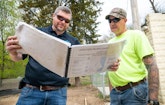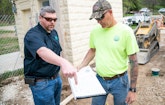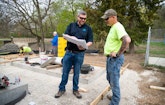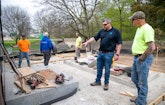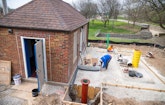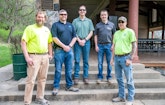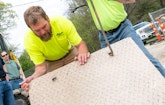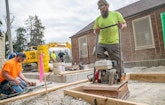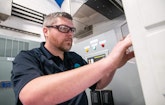Interested in Infrastructure?
Get Infrastructure articles, news and videos right in your inbox! Sign up now.
Infrastructure + Get AlertsAt the foot of Grandview Drive, which Teddy Roosevelt famously dubbed “the world’s most beautiful drive,” Greater Peoria Sanitary District engineers are doing something pretty attractive in its own right. They are filling a nearly-75-year-old brick building with 21st-century sewer pumping components to make the Illinois district’s sewer system more efficient and reliable.
The pumping station was constructed in 1949 — more than three decades after the 26th U.S. president made his observation about the scenic drive — and it has served the sanitary system well. However, it was last upgraded about 40 years ago and district officials concluded it was time for a makeover.
“The pumps were getting to the end of their useful life,” says Josh Auxier, the district’s lead engineer on the project. “We could have rebuilt them, putting in new parts here and there. That was one option. We decided to go in with a clean slate and rehab the whole thing.”
The project is about 90% complete. G.A. Rich & Sons is prime contractor.
No simple feat
The Grandview station is not the largest of the district’s 16 pump houses, but it is important. “We have much bigger ones, but the Grandview station is critical because it is fed by two other pump stations on the Illinois River. At times of flooding, they take on a lot of water. So, in addition to being very old, they didn’t have the capacity to pump what we needed to have pumped.”
Transforming the interior of the building into a state-of-the-art pumping station was not as simple as deftly substituting one pump for another. For one thing, the building is small — 12 feet by 28 feet — and the new variable frequency 10-inch self-priming centrifugal drive pumps are much larger than the ones being replaced. “The new VFD pumps are massive by comparison,” Auxier says.
The brick structure originally was built to house two 8-inch pumps. In the 1980s, the two pumps were traded out for three 6-inch pumps. The three-level station has controls on the second level (underground) with the wet well on the level below that. Each level is connected by a stairway.
Because of where the building is situated, razing it and starting from scratch wasn’t feasible, says Auxier, acknowledging “that would have been easier.” Fitting the new pumps inside the cramped space was a challenge that he and his engineering team only met using 3D software.
“We brought in a 3D laser scanner and used it to build a full-dimensioned model of the pumps and pump infrastructure and stairs,” the engineer says. “We spent quite a bit of time just determining if it all would fit in there. We did 14 iterations of the model just to get it to fit around the stairs.”
The new 10-inch VFD controlled pumps are Gorman-Rupp units, which are popular in the district. “We’ve had tremendous success with the Gorman-Rupp pumps. They are some of our favorites. They require very little maintenance and flat-out run.”
The two variable-frequency drive pumps replaced three pumps that were configured to run in parallel. That is, one pump was turned on to handle normal flow, then a second one when flow increased, and the third one at periods of high flow. While that worked, it meant that each of the pumps was run wide open whenever it was in use. It was a simple on-off operation technology with no ability to moderate pump speed.
Whereas the VFD units can fluctuate their operating speed. That not only gives the pumps variability in matching output to flow rates, it lengthens their service life by reducing physical wear on components.
“That 10-inch pump running full bore at 1,450 rpm is like a 100 hp pump, but when it’s run at 925 rpm, it’s the equivalent of a 30 hp pump. We won’t see a huge savings in electricity consumed by the new pumps, but it dramatically increases our flexibility in moving wastewater.”
Everything new
Transitioning a sanitary system pump station is not a matter of simply taking it offline during the fix. In this case, the fix has taken most of a year — far longer than anticipated — and the community’s wastewater never stopped moving through the system toward the treatment plant.
To keep the waste flowing, the first stage of the project was replacement of an old brick manhole upstream from the pump station with a precast concrete manhole containing a sheer valve that would block flow to the station. The existing force main downstream from the pump station then was uncovered and a bypass line from the new manhole was looped around the station and connected to the main, using portable pumping equipment. The whole Grandview project cost $1.3 million.
The rehabbed pumping station is computer operated or will be when in full operation. All the systems were upgraded. “Every piece of electrical wiring in the building is new, all auxiliary components of the pumps are new. Everything is new.” To accomplish all that, Auxier says as many as 15 workers were crowded into the small building during the height of the overhaul.
The district’s engineering staff and maintenance crews learned a lot in the course of revamping the old station — and will put it all to good use when they undertake the identical rehabilitation of a station upstream from the Grandview building. Once again, a 3D laser scanner will produce a model to guide the work, but this time Auxier and his team will bring the Grandview building experience to the task.
Greater Peoria Sanitary District has 16 pumping stations. All are to be overhauled eventually to some extent. The general goal is to make them more efficient and reliable. “Sometimes ‘reliable’ means extra capacity. Sometimes it means backup power,” Auxier says.
Station overhauls, including insertion of VFD controlled pumps and incorporating modern controls, are a trend in the industry as utilities strive to become more and more efficient. Yet this Peoria project was different, too. “Lots of places would have just torn down the building. We salvaged it and kept costs down. We tackled the job in a way that was economically efficient, using 3D design technology. The way we approached it might lead the industry.”
Progressive maintenance
The sanitary district serves a broad area and includes quite a variety of customers, from a Komatsu machinery manufacturing plant to the campus of Bradley University to homeowners. About 70% of wastewater sent to the system’s treatment plant is industrial or commercial. One reason why is a BioUrja corn-processing plant that produces ethanol and alcohol products. Auxier says the plant is a big component in the district’s wastewater.
“All the wastewater is treated the same, but our treatment plant is designed around the load we get. We have a larger ammonia load than some systems because of the industrial effluent, so we are geared up to handle the higher loads.” Average flow into the treatment plant is 25 mgd, but its capacity is 154 mgd.
The district’s pipe infrastructure is “fairly old,” Auxier says, probably averaging 50-plus years, “but we do a lot of in-place rehab work with lining. We have an annual contract for in situ lining.” The bulk of the pipe is 8- to 10-inch stock, which carries wastewater to a pair of 84-inch interceptor lines.
Maintaining the district’s lines largely falls to a full-time cleaning crew that keeps tabs on the infrastructure with video inspection cameras and hydrovac trucks. The crew performs light repair tasks, but major leaks or pipe replacement jobs are contracted out. A Peoria firm, JC Dillon Inc., has won the annual repair contract for several years.
Auxier says the district tries to be progressive in its oversight and maintenance of the sewer system. He cites the use of drones to survey projects from the air. “We try to be cutting edge in our work. We try to put all the pieces together to get a good result and do it while being light on the manpower. We want to be good stewards of the money that comes to us.”
The next big project is an overhaul of the system’s treatment plant, a $30 million upgrade. Construction on the plant began in 1927 — nearly a hundred years ago — but the facility is continually rehabbed. “We’re working on the bones of a 1929 plant and just keep breathing new life into the old place.”
The first phase of the work will be reinforcing levees that protect the plant from Illinois River waters flowing right next to it. “That’s my next big project,” Auxier says. “We’ve had three major floods in the last 10 years and there is a quarter-billion-dollar facility sitting inside that levee. It’s a huge thing we’re looking at.”

